ELA
Senior Member
- Occupation
- Electrical Test Engineer
I started this thread to share (apologies for the length) what I thought was interesting information on one of the many possible causes for LED bulb flicker/strobing. There have been a great many reports of LED bulb flicker and one post here really peaked my interest.
That post as titled “ All LEDs in House Flicker In Sync - PoCo No Help”.
The idea that a smart meter using Two-Way Automatic Communications System [TWACS] PLC could upset dimmers was very interesting to me.
After reading as much as I could find on TWAC communications (Proprietary) I set out to attempt to simulate a small distortion of the sinewave, near zero cross, to examine its affect on some dimmers.
To accomplish this I used a Crydom SSR controlled by a Microcontroller to adjust the turn on time from 0 -900usec ( 0- approx. 20 degrees after zero cross). This then feeds 25Watt incandescent load ( to provide a minimum latching current) for the SSR. This then becomes the "Simulated Source or incoming line voltage”). This is intended be a very rough approximation of a TWACs – or other zero cross distortion. The intent was to simply delay the zero-cross signal, not to simulate the TWAC exactly, as that is much more complex and proprietary.
I then used this zero-cross delayed source to feed a couple of different Dimmers to try and evaluate any effect and whether or not it could produce an LED Flicker/strobe effect. Along the way I also evaluated a Jasco LED-Bypass device as a possible cure to some LED flicker/strobe effects. The results of that I found very interesting. They describe their Bypass device as being capacitive? Yet it behaves more like a “voltage range sensitive” resistive load. Not what I expected so thought it might be interesting to share.
I tested a common home automation dimmer (Insteon) and also a Lutron ( MA-PRO) dimmer with Incandescent and LED loads.
The results were: that either the Insteon or the MA-PRO in “phase forward” mode were more immune to a Zero-Cross Corruption (turn on Delay) then the MA-PRO was when in “Phase Reverse mode”. Phase reverse mode is the default mode for the Lutron MA-PRO Dimmer.
The Phase Reverse Mode was much more susceptible to a zero cross distortion ( delay) than the Phase Forward Mode. With a turn on Delay of only (8 degrees), 350 usec, the MA-PRO in reverse mode would cause the LED Load to flicker/Strobe.
When in phase forward mode it did not flicker up to 900usec ( Which is the Max limit of the SSR used as the tester source ).
Below are some O'scope captures for anyone interested in Oscilloscope detail ( volts and current for most ):
In the Dimmer pictures below the dimmer load was a 40W (equiv, 5W actual) Phillips LED load.
At the very end are two captures showing use of a Jasco bypass device to assist as a minimum load, and a "solar cell based Dimmer miss-fire detector".
<Fig1: SSR Simulated Source used to feed the dimmers at 350usec delay – 25W incandescent min. load for SSR only>
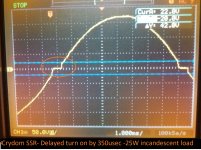
<Fig2: Insteon Dimmer – phase forward mode- full on, 40W LED Dimmer load

<Fig3: MA-PRO dimmer – reverse phase, full on –, 40W LED Dimmer load
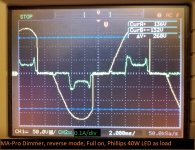
<Fig4: Intermittent ½ wave drop outs due to 350us turn on delay, on MA-PRO in reverse mode
This was interesting to see how when the dimmer is on the edge of its ability to maintain the required minimum load requirement, when turning on near zero cross, that flicker/strobe results. The dimmer randomly experiences a valid triggers, v.s. half-cycle mis-fires.
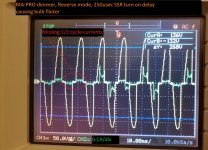
<Fig5: Jasco LED Bypass device as only load- to show where it turns On/Off
Note how the Jasco device turns on very close to zero cross and then turns off at around 12 degrees or so. Providing the required minimum load current, but only for the amount of time where most critical, as the incoming line voltage is rising high enough. Or has fallen very low.
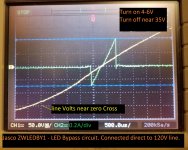
<Fig6: Adding a Jasco device to the MA-PRO load, in reverse phase mode, with 350usec delayed source. Eliminates the Flicker/Strobe. Note current trace is inverted for better view without overlay.
This is not intended to imply that the Jasco device is a cure all for all flicker/strobe issues. Just to demonstrate how it might work in some cases.
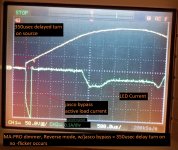
----------------------
I also experimented with using a typical yard LED spot light type solar cell as a sensing device. I was curious if the solar cell output voltage could be used to detect an LED bulb flicker. I found that worked reasonably well and could be used as a “trigger” signal to an Oscope in order to capture the AC line sinewave at the moment of disturbance. Below shows the dip in the dc output at the time of a missing half cycle of current to the bulb during a flicker/strobe event. A side note to this test was that the 40W incandescent lamp illumination produced a much higher solar cell output than the equivalent LED bulb did. Due to the solar cell being more sensitive to the red wavelength end of the spectrum.
< Fig7: Solar cell output voltage at the time of a ½ cycle drop out event
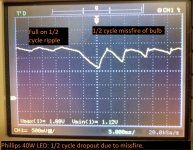
This may be a bit much all at once. Not intended for everyone, just those that might be interested in Oscope details. Was an attempt to help understand if TWACS zero cross distortions might cause an LED flicker. I have a TWACS meter in my house, and lots of dimmers and LEDs, but have not experienced flicker issues. However I do not know at what time of day my meter communicates and the power company did not respond to my request for that info.
That post as titled “ All LEDs in House Flicker In Sync - PoCo No Help”.
The idea that a smart meter using Two-Way Automatic Communications System [TWACS] PLC could upset dimmers was very interesting to me.
After reading as much as I could find on TWAC communications (Proprietary) I set out to attempt to simulate a small distortion of the sinewave, near zero cross, to examine its affect on some dimmers.
To accomplish this I used a Crydom SSR controlled by a Microcontroller to adjust the turn on time from 0 -900usec ( 0- approx. 20 degrees after zero cross). This then feeds 25Watt incandescent load ( to provide a minimum latching current) for the SSR. This then becomes the "Simulated Source or incoming line voltage”). This is intended be a very rough approximation of a TWACs – or other zero cross distortion. The intent was to simply delay the zero-cross signal, not to simulate the TWAC exactly, as that is much more complex and proprietary.
I then used this zero-cross delayed source to feed a couple of different Dimmers to try and evaluate any effect and whether or not it could produce an LED Flicker/strobe effect. Along the way I also evaluated a Jasco LED-Bypass device as a possible cure to some LED flicker/strobe effects. The results of that I found very interesting. They describe their Bypass device as being capacitive? Yet it behaves more like a “voltage range sensitive” resistive load. Not what I expected so thought it might be interesting to share.
I tested a common home automation dimmer (Insteon) and also a Lutron ( MA-PRO) dimmer with Incandescent and LED loads.
The results were: that either the Insteon or the MA-PRO in “phase forward” mode were more immune to a Zero-Cross Corruption (turn on Delay) then the MA-PRO was when in “Phase Reverse mode”. Phase reverse mode is the default mode for the Lutron MA-PRO Dimmer.
The Phase Reverse Mode was much more susceptible to a zero cross distortion ( delay) than the Phase Forward Mode. With a turn on Delay of only (8 degrees), 350 usec, the MA-PRO in reverse mode would cause the LED Load to flicker/Strobe.
When in phase forward mode it did not flicker up to 900usec ( Which is the Max limit of the SSR used as the tester source ).
Below are some O'scope captures for anyone interested in Oscilloscope detail ( volts and current for most ):
In the Dimmer pictures below the dimmer load was a 40W (equiv, 5W actual) Phillips LED load.
At the very end are two captures showing use of a Jasco bypass device to assist as a minimum load, and a "solar cell based Dimmer miss-fire detector".
<Fig1: SSR Simulated Source used to feed the dimmers at 350usec delay – 25W incandescent min. load for SSR only>

<Fig2: Insteon Dimmer – phase forward mode- full on, 40W LED Dimmer load

<Fig3: MA-PRO dimmer – reverse phase, full on –, 40W LED Dimmer load

<Fig4: Intermittent ½ wave drop outs due to 350us turn on delay, on MA-PRO in reverse mode
This was interesting to see how when the dimmer is on the edge of its ability to maintain the required minimum load requirement, when turning on near zero cross, that flicker/strobe results. The dimmer randomly experiences a valid triggers, v.s. half-cycle mis-fires.

<Fig5: Jasco LED Bypass device as only load- to show where it turns On/Off
Note how the Jasco device turns on very close to zero cross and then turns off at around 12 degrees or so. Providing the required minimum load current, but only for the amount of time where most critical, as the incoming line voltage is rising high enough. Or has fallen very low.

<Fig6: Adding a Jasco device to the MA-PRO load, in reverse phase mode, with 350usec delayed source. Eliminates the Flicker/Strobe. Note current trace is inverted for better view without overlay.
This is not intended to imply that the Jasco device is a cure all for all flicker/strobe issues. Just to demonstrate how it might work in some cases.

----------------------
I also experimented with using a typical yard LED spot light type solar cell as a sensing device. I was curious if the solar cell output voltage could be used to detect an LED bulb flicker. I found that worked reasonably well and could be used as a “trigger” signal to an Oscope in order to capture the AC line sinewave at the moment of disturbance. Below shows the dip in the dc output at the time of a missing half cycle of current to the bulb during a flicker/strobe event. A side note to this test was that the 40W incandescent lamp illumination produced a much higher solar cell output than the equivalent LED bulb did. Due to the solar cell being more sensitive to the red wavelength end of the spectrum.
< Fig7: Solar cell output voltage at the time of a ½ cycle drop out event

This may be a bit much all at once. Not intended for everyone, just those that might be interested in Oscope details. Was an attempt to help understand if TWACS zero cross distortions might cause an LED flicker. I have a TWACS meter in my house, and lots of dimmers and LEDs, but have not experienced flicker issues. However I do not know at what time of day my meter communicates and the power company did not respond to my request for that info.

